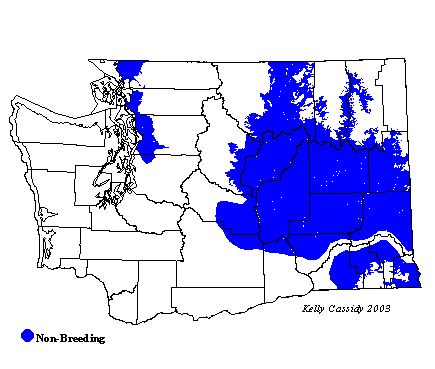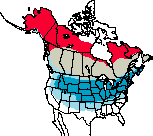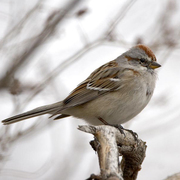American Tree Sparrow
General Description
The American Tree Sparrow is a small sparrow with a long notched tail. The adult has a streaked back and wings, with two white wing bars, but is otherwise unstreaked, while the juvenile is streaky overall. Adults have an unstreaked gray-brown breast and belly, with a dark spot in the center. The tail, rump, and nape of the neck are all solid gray. The upper mandible of the bill is dark and the lower is yellow. The head is mostly gray, with a rufous crown and eye-line.
Habitat
The American Tree Sparrow is actually not closely associated with trees. Its breeding habitat is in the far north, in the shrubby tundra beyond the tree-line. In winter and during migration, they inhabit a variety of open habitats, including dry grassland, sagebrush desert, and farmland. They can also be found in woodlands bordering rivers, shrubby thickets and other weedy edges, and yards with birdfeeders.
Behavior
Outside of the nesting season, Tree Sparrows are usually found foraging in flocks in low bushes or on the ground. In snowy fields, they will beat tall weeds with their wings and collect the fallen seeds from atop the snow.
Diet
Seeds, insects, and berries make up most of the American Tree Sparrow's diet. In winter, they eat primarily seeds and berries, while in summer their diet shifts to insects, especially when feeding young.
Nesting
The male defends a territory, and the monogamous pair forms shortly after the birds arrive on the breeding grounds. The nest is an open cup of twigs, grass, and moss, often lined with ptarmigan feathers and other fine material. It is situated on the ground, on grass clumps or hummocks in the open tundra. The female incubates the 4-6 eggs for 12-13 days. Both parents feed the young who leave the nest after 8-10 days and can fly at two weeks of age. The parents continue to feed the young for about two weeks after they leave the nest.
Migration Status
American Tree Sparrows are complete migrants, meaning there is no overlap between breeding and wintering range. Migration is late in the fall and early in the spring, with the birds spending the breeding season in the far north.
Conservation Status
Most of the American Tree Sparrow's nesting area is remote from human disturbance and well protected, although large-scale development in the far north may threaten this species. On the wintering grounds, residential gardening practices such as clearing underbrush, removing weeds, and cutting grass reduce the food supply, but feeding stations often make up for this and American Tree Sparrows have adapted well to living in suburban environments and are currently considered abundant.
When and Where to Find in Washington
Mostly an eastern Washington species, the American Tree Sparrow is found in Washington only during the winter. It is locally uncommon in eastern Washington from October to March, with some birds lingering into early April. In western Washington, it is locally uncommon to rare in scattered areas, including Bellingham (Whatcom County), Camano Island (Island County), Snoqualmie and Snohomish River valleys, Skagit River delta, and Monroe (Snohomish County). Look for it in deciduous trees and brush along edges and watercourses in relatively open habitat.
 Abundance
Abundance
| Ecoregion | Jan | Feb | Mar | Apr | May | Jun | Jul | Aug | Sep | Oct | Nov | Dec |
|---|---|---|---|---|---|---|---|---|---|---|---|---|
| Oceanic | ||||||||||||
| Pacific Northwest Coast | ||||||||||||
| Puget Trough | R | R | R | R | R | |||||||
| North Cascades | R | R | R | R | ||||||||
| West Cascades | ||||||||||||
| East Cascades | R | R | R | R | R | R | ||||||
| Okanogan | U | U | R | R | U | |||||||
| Canadian Rockies | U | U | U | U | U | U | ||||||
| Blue Mountains | R | R | R | |||||||||
| Columbia Plateau | U | U | R | R | U | U |
Washington Range Map

North American Range Map


Family Members
 Green-tailed TowheePipilo chlorurus
Green-tailed TowheePipilo chlorurus Spotted TowheePipilo maculatus
Spotted TowheePipilo maculatus American Tree SparrowSpizella arborea
American Tree SparrowSpizella arborea Chipping SparrowSpizella passerina
Chipping SparrowSpizella passerina Clay-colored SparrowSpizella pallida
Clay-colored SparrowSpizella pallida Brewer's SparrowSpizella breweri
Brewer's SparrowSpizella breweri Vesper SparrowPooecetes gramineus
Vesper SparrowPooecetes gramineus Lark SparrowChondestes grammacus
Lark SparrowChondestes grammacus Black-throated SparrowAmphispiza bilineata
Black-throated SparrowAmphispiza bilineata Sage SparrowAmphispiza belli
Sage SparrowAmphispiza belli Lark BuntingCalamospiza melanocorys
Lark BuntingCalamospiza melanocorys Savannah SparrowPasserculus sandwichensis
Savannah SparrowPasserculus sandwichensis Grasshopper SparrowAmmodramus savannarum
Grasshopper SparrowAmmodramus savannarum Le Conte's SparrowAmmodramus leconteii
Le Conte's SparrowAmmodramus leconteii Nelson's Sharp-tailed SparrowAmmodramus nelsoni
Nelson's Sharp-tailed SparrowAmmodramus nelsoni Fox SparrowPasserella iliaca
Fox SparrowPasserella iliaca Song SparrowMelospiza melodia
Song SparrowMelospiza melodia Lincoln's SparrowMelospiza lincolnii
Lincoln's SparrowMelospiza lincolnii Swamp SparrowMelospiza georgiana
Swamp SparrowMelospiza georgiana White-throated SparrowZonotrichia albicollis
White-throated SparrowZonotrichia albicollis Harris's SparrowZonotrichia querula
Harris's SparrowZonotrichia querula White-crowned SparrowZonotrichia leucophrys
White-crowned SparrowZonotrichia leucophrys Golden-crowned SparrowZonotrichia atricapilla
Golden-crowned SparrowZonotrichia atricapilla Dark-eyed JuncoJunco hyemalis
Dark-eyed JuncoJunco hyemalis Lapland LongspurCalcarius lapponicus
Lapland LongspurCalcarius lapponicus Chestnut-collared LongspurCalcarius ornatus
Chestnut-collared LongspurCalcarius ornatus Rustic BuntingEmberiza rustica
Rustic BuntingEmberiza rustica Snow BuntingPlectrophenax nivalis
Snow BuntingPlectrophenax nivalis McKay's BuntingPlectrophenax hyperboreus
McKay's BuntingPlectrophenax hyperboreus

